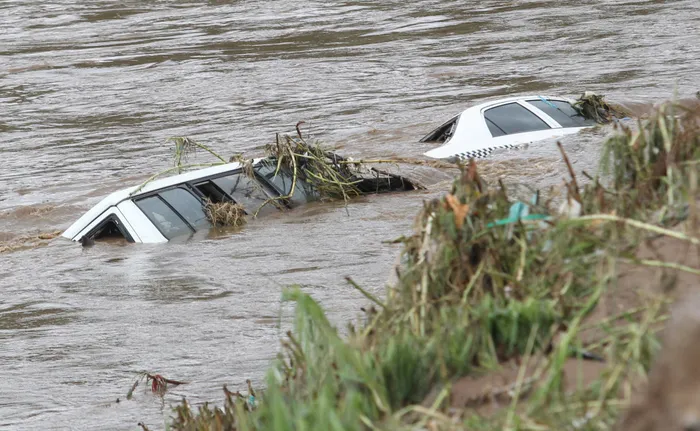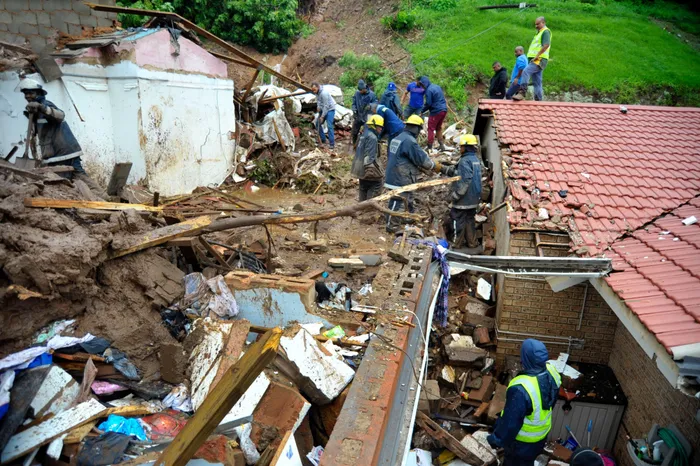How KwaZulu-Natal is rebuilding after the devastating April 2022 floods

The April 2022 floods left more than 400 people dead and caused a trail of destruction to infrastructure, businesses, homes and communities.
Image: Doctor Ngcobo/ Independent Media
Three years on since the floods which saw torrential rains batter KwaZulu-Natal, causing death to over 400 people, damage to infrastructure, loss to property, businesses, and dislocating families, the province is still on the road to recovery.
The floods exposed infrastructure fragility and the consequences of inadequate planning and maintenance, as roads buckled, bridges collapsed, and essential services like water and electricity were severely disrupted.
The eThekwini Metro and the South Coast were amongst the hardest hit areas.
The disaster highlighted the deep-seated social and economic vulnerabilities within the province, with informal settlements, often located in high-risk areas, bearing the brunt of the devastation.
eThekwini Municipality spokesperson Mandla Nsele said following the devastating floods in April 2022, the city has significantly progressed in restoring and upgrading its electricity infrastructure.
"The current replacement cost of the eThekwini Metropolitan Municipality's infrastructure is estimated at R461 billion," he said.
“Five distribution substations were condemned and are slated for replacement. Major substations have been replaced, cleaned up, and energised after passing pressure tests.
At the Mariannridge High Voltage Substation, the equipment installation is complete, commissioning is underway, and is expected to be completed by the end of July 2025.
"At the Toyota substation, the temporary mobile switchgear has been installed, permanent 11kV switchgear procurement is in the final stages, expected delivery early next year, and civil structure repairs at affected other substations have been completed,” Nsele said.
"After the April 2022 floods, the Durban Coalition was established to collectively build a united and coordinated participatory civil society movement designed to strengthen civil structures and to engage constructively with local and other spheres of government to respond to social and environmental justice issues," he said.
Nsele added that the Durban South Basin was amongst the severely impacted areas during the April 2022 floods.
"The uMlazi Canal was one of the major infrastructures that was affected, and its repairs are currently underway. The city is driving a multi-stakeholder collaboration to upgrade the uMlazi Canal through the support of the Presidential eThekwini Working Group.
"The collaboration seeks to promote alignment, sharing resources towards the development of disaster-resistant urban infrastructure," he said.

More than 400 people died and thousands of homes were destroyed or damaged during the April 2022 floods.
Image: Theo Jeptha/Independent Media
"The eThekwini Municipality, which has a large and complex infrastructure base through which it provides essential services to communities, has over the last eight to ten years experienced recurring heavy floods, which carry a heavy cost on people, the economy, and infrastructural resources," Nsele said.
He added that eThekwini Municipality’s stormwater systems are designed to cope with a one-in-10-year storm event flow at critical points. However, the 2017, 2019, 2022, and 2023 floods were greater than the 1:100-year flood in certain parts of the city.
“Some of the proactive initiatives the city is implementing to reduce flooding risks include the Sihlanzimvelo pilot programme, where the city maintains approximately 500km of streams in high-risk areas. The city is also revising the flood lines to incorporate the projected climate impact of a 15 percent increase in rainfall intensity,” he said.
According to Nsele, the Disaster Management Centre, in consultation with the relevant stakeholders, has prepared the winter and summer season contingency plan to ensure preparedness and the state of readiness to respond.
Martin Meyer, KwaZulu-Natal MEC for Public Works, said they are researching more resilient building methods, but this is dependent on client Departments, “but we are carrying out education with client departments to promote the use of more client-resilient building methods.
“We are looking at and reaching out to private role players and other foreign role players like the European Union to see how we can improve on flood defenses, but these are almost non-existing in KZN and we are spending a lot of time and effort to see how we can improve flood defenses to protect our infrastructure. The Premier (Thamsanqa Ntuli) has also announced a Climate Change Committee that will meet regularly,” Meyer said.
Thulasizwe Buthelezi, KZN MEC for Cooperative Governance and Traditional Affairs, said that through the Cogta disaster housing programme, they aim to restore the damaged public infrastructure and services and rebuild communities in a manner that enhances resilience to future hazards.
"This includes integrating risk reduction measures, improving land use planning, and building climate-resilient infrastructure. The province has responded to wildfires, flooding, snowstorms, and lightning incidents," he said.
“To strengthen the province’s disaster response capability, MOUs have been signed with various social partners who are contributing expertise and resources to enhance our disaster response and mitigation strategies,” Buthelezi said.
Siboniso Duma, KZN MEC for Human Settlements and Transport, said whilst they were in the process of providing dignity to the victims affected by the 2022 floods, the province was again struck by devastating rainfalls.
“We are in the process of coming up with ways and means to respond to climate change. This includes exploring building new technology and learning through practice from other countries,” Duma said.
Dr Msizi Myeza, a town planner and chief executive of the Council for the Built Environment (CBE), said the floods brought to the fore several significant town planning oversights and vulnerabilities that need urgent attention.
He said these include inadequate flood risk assessment, poor land-use planning that allowed development in high-risk flood zones, and worsening the impact of the devastation.
He added that the insufficient infrastructure, stormwater systems, and water management systems made matters worse, with roads, bridges, and drainage systems unable to cope.
"There are vital changes that need to be made to our urban planning to mitigate such damage in the future," he added.
“We need detailed flood risk mapping for the entire KwaZulu-Natal to inform development decisions, and the zoning regulations must be implemented to restrict building in high-risk flood zones. Crucially, our infrastructure needs major upgrades—our roads, drainage systems, and bridges must be able to withstand extreme weather events.
“We also need to relook at our existing spatial development frameworks that are flawed, further contributing to such disasters. The lack of enforcement has allowed unregulated development in high-risk zones, with insufficient risk assessments performed for spatial planning decisions,” Myeza said.
gcwalisile.khanyile@inl.co.za
